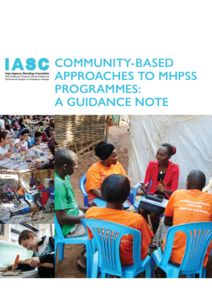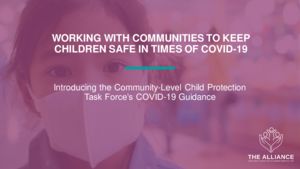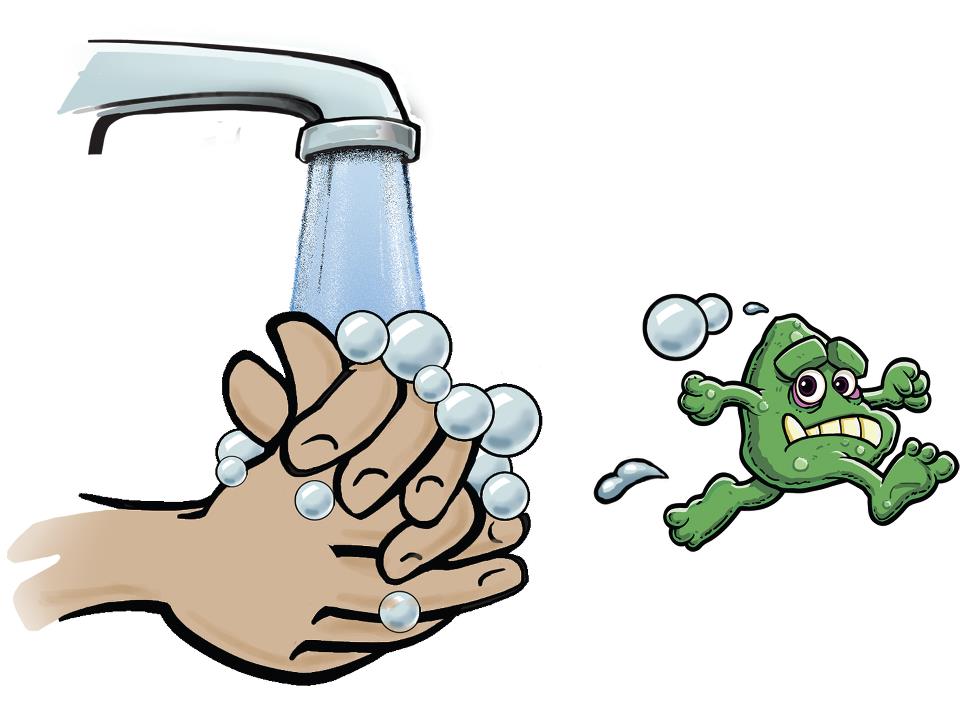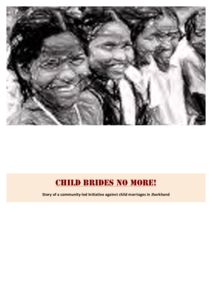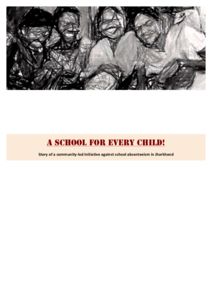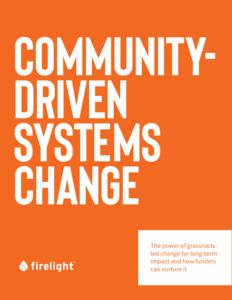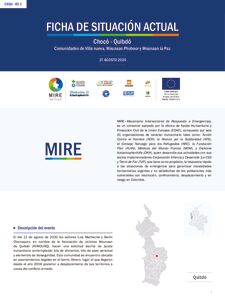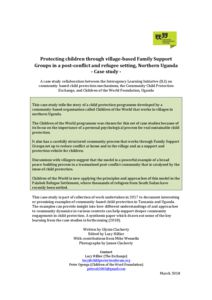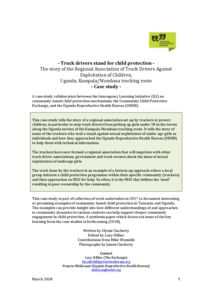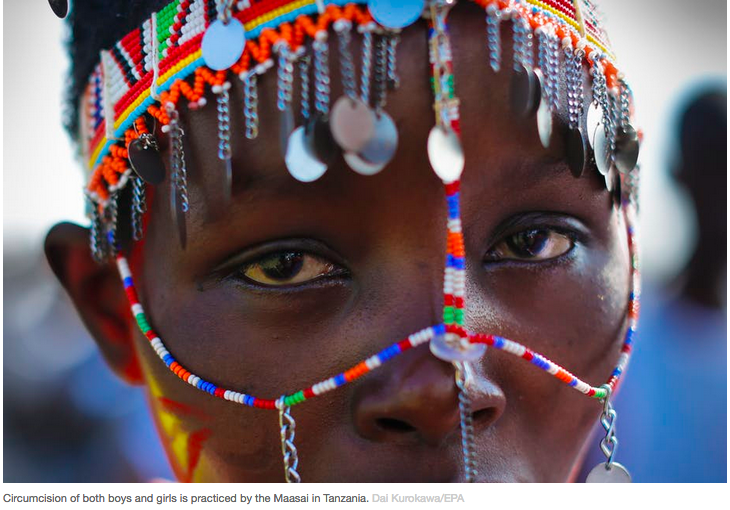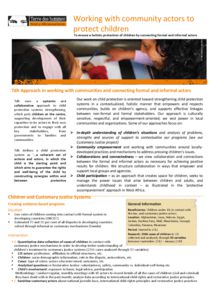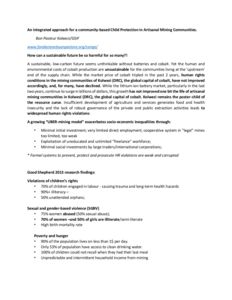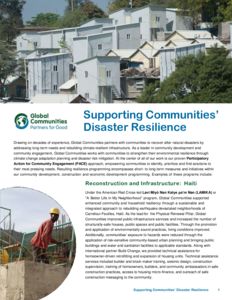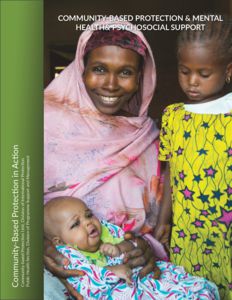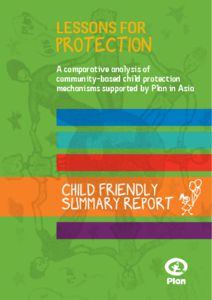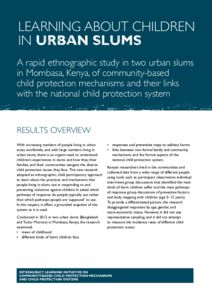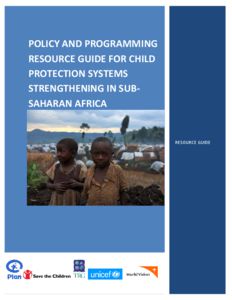Reconsidering child protection systems: Critical reflections
Published: No date
Author: Bill Forbes, Alexander Krueger, Nicole Behnam, Philip Cook, Mike Wessells and John Williamson
This paper examines the most recent large-scale development in child protection work—the shift from individual child protection projects towards strengthening national child protection systems.
COMMUNITY-BASED APPROACHES TO MHPSS PROGRAMMES: A GUIDANCE NOTE
Published: No date
Author: Inter-Agency Standing Committee’s Reference Group on MHPSS in Emergency Settings
Putting communities at the centre of humanitarian MHPSS response enables self-efficacy, reducing the impact of what is “delivered” and enhancing the significance of what is “built” together.
Webinar presentation: Working with communities to keep children safe (annex to the Inter-agency Technical Note on the Protection of Children during the Coronavirus Pandemic)
Published: May, 2020
Author: The Alliance for Child Protection in Humanitarian Action
Maybe you joined the webinar launch of Working with communities to keep children safe (annex to the Inter-agency Technical Note on the Protection of Children during the Coronavirus Pandemic)? Even if you missed it, you can now access the webinar recording as well as the presentation slides.
Read the PDF presentation: You can download a pdf of the presentation with notes here. Slides 15-16 are not fully functional as they are audio and video slides.
The link to slide 15 is “CELLPHILMS: A HOW TO” by Casey Burkholder – A 60 second cellphilm on how to make a cellphilm
The link to slide 16 is 18 year old Luzuko’s experience during COVID-19 pandemic, supported by RX Radio SA (Red Cross Children’s Hospital in Cape Town South Africa).
Watch the webinar: You can now watch the webinar on Facebook here. Please note that the presentation contains video and audio which can only be accessed by watching the recording of the webinar.
Read the guidance: Read Working with communities to keep children safe (annex to the Inter-agency Technical Note on the Protection of Children during the Coronavirus Pandemic).
Find practical tools: If you are looking for ideas and materials which can support this guidance, follow the links in the guidance and also visit the Exchange’s updated list of practical tools and materials here.
Newsletter #1 2020: COVID-19, Communities and Children
Published: March 2020
Author: Communy Child Protection Exchange
Our first 2020 newsletter focuses entirely on the current COVID-19 outbreak and unprecedented global efforts to try and contain this pandemic. As child protection practitioners, we’ve been asking ourselves how COVID-19 impacts children and communities, how we can continue to provide services and support, and how can prevention strategies be adapted to our contexts? Many practitioners might also be wondering how it will affect them professionally and personally.
We’ve collected together some key resources here which can help support strong community responses to the outbreak and help keep children, and the people they rely on, safe (and that includes practitioners!). It’s worth noting that we are all still learning about this new virus and promising community strategies. So far, there’s very little documentation of community level responses to COVID-19 that we can find. In the meantime, global agencies have been very quick to produce useful guidance and other materials, and we can also draw on previous learning from other infectious disease outbreaks, such as Ebola.
Newsletter #3 2020. COVID-19: Let’s get technical
Published: June 2020
Author: Community Child Protection Exchange
A LOT of guidance has been drafted on coronavirus and its impact on children since early March, including a range of “technical notes”. Here, we shine a spotlight on the technical notes which are relevant to children’s wellbeing, and how they might help guide our community-led child protection work during this time.
But firstly, what is a technical note? In the COVID-19 and children’s wellbeing context a technical note is a brief which lays out the main considerations as well as our understandings so far on how and why children are or could be impacted by the pandemic. The notes might also suggest how to address these issues programmatically and sometimes through advocacy and policy. Mostly, they are developed collaboratively between different agencies, and are designed to align with each other and other global guidance and tools, including the 2019 edition of the Minimum Standards for Child Protection in Humanitarian Action.
Technical notes are very useful in helping us understand key issues affecting children during COVID-19, as well as focusing our thinking. However, as they are written for a global audience, we also need to ensure we read them from the perspective of the contexts where we are working.
Newsletter #2 2020: Working remotely for community child protection
Published: April 2020
Author: Community Child Protection Exchange
We had a great response to our first COVID-19 newsletter, and it’s clear that many of us are urgently looking for practical guidance and tools to help us carry out our work whilst dealing with all the challenges of COVID-19.
In the last few weeks A LOT of technical guidance and materials on COVID-19 have been developed. We are aiming to share all this information with you in an ongoing manner and in the most digestible way possible.
This edition of the newsletter focuses on practical ideas, resources and information hubs which can help you continue to operate your child protection programmes from a distance. You may be confined to your office or your house, yet there are still ways to provide a level of support and to keep in touch with communities. Use these resources to inspire you and adapt to your context.
COVID-19: List of practical resources and tools to support community child protection
Published: April 20, 2020
Author: Lucy Hillier for the Community Child Protection Exchange
This list of practical resources and tools supports the guidance developed in April 2020 by the Community-level Child Protection Task Force (Task Force) of the Alliance for Child Protection in Humanitarian Action (Alliance) for child protection actors who are working in or with communities to keep children safe during COVID-19. In turn, the Task Force’s guidance builds on the Alliance’s technical note: Protection of Children during the Coronavirus Pandemic.
As of 20 April, 2020, both of these documents above were in the final stages of completion and will be linked and available here in the coming days. For those who would like to be alerted by mail, please join our mailing list by mailing [email protected].
CHILD BRIDES NO MORE! Story of a community-led Initiative against child marriages in Dhanbad, Jharkhand
Published: 2021
Author: The Inter-Agency Core Group CINI, Chetna Vikas, Child Resilience Alliance, Plan India, & Praxis
A short, illustrated story of a community-led initiative to end child marriages in Dhanbad, Jhakahand, India.
A SCHOOL FOR EVERY CHILD! Story of a community-led Initiative against school absenteeism in Jharkhand
Published: 2021
Author: The Inter-Agency Core Group CINI, Chetna Vikas, Child Resilience Alliance, Plan India, & Praxis
A short, illustrated story of a community-led initiative against school absenteeism in Khunti, Jharkhand, India.
Community-driven systems change
Published: 2021
Author: Firelight Foundation
The power of grassroots-led change for long-term impact, and how funders can nurture it.
Guidance on Community Social Distancing During COVID-19 Outbreak
Published: 2020
Author: Africa centres for disease control and prevention (AFRICA CDC)
In Africa, the number of COVID-19 cases and impacted countries has been increasing steadily. As of 12 March 2020, 129 cases have been diagnosed in 12 countries, with one death recorded. The experience in countries outside Africa is that, after initial cases are diagnosed, community transmission occurs rapidly. Member States need to immediately implement individual social distancing and plan to implement community social distancing.
Ficha de situación – Chocó: Quibdó
Published: 2020
Author: MIRE–Mecanismo Intersectorial de Respuesta a Emergencias
Ficha de situación – Chocó: Quibdó. Comunidades de Villa nueva, Wounaan Phoboor y Wounaan la Paz.
Protecting children through village-based Family Support Groups in a post-conflict and refugee setting, Northern Uganda: A Case Study
Published: 2018
Author: Written by Glynis Clacherty, edited by Lucy Hillier, with contributions from Mike Wessells for the Interagency Learning Initiative (ILI)
This case study tells the story of a child protection programme developed by a community-based organisation called Children of the World that works in villages in northern Uganda. The Children of the World programme was chosen for this set of case studies because of its focus on the importance of a personal psychological process for real sustainable child protection.
Truck drivers stand for child protection – The story of the Regional Association of Truck Drivers Against Exploitation of Children, Uganda, Kampala/Mombasa trucking route: A Case Study
Published: 2018
Author: Written by Glynis Clacherty, edited by Lucy Hillier, with contributions from Mike Wessells for the Interagency Learning Initiative (ILI)
This case study tells the story of a regional association set up by truckers to protect children, in particular to stop truck drivers from picking up girls under 18 in the towns along the Uganda section of the Kampala-Mombasa trucking route. It tells the story of some of the truckers who took a stand against sexual exploitation of under-age girls as individuals and how they approached the Uganda Reproductive Health Bureau (URHB) to help them with technical information.
How practices, and meaning, of genital cutting are changing in Tanzania
Published: 2018
Author: Hannelore Van Bavel a,b , Gily Coene c and Els Leye for "The Conversation"
Among the Maasai the circumcision of both boys and girls serves as a rite of passage from childhood to adulthood. Efforts to discourage the practice haven’t always resulted in fewer Maasai girls being cut. But new research shows that they have had an impact on the cultural meaning of the ceremonial rite of passage, as well as its context. Hannelore van Bavel, Els Leye and Gily Coene explain.
Communiqué from the Interagency Learning Initiative (ILI) on Community-based Child Protection Mechanisms and Systems – Entebbe, Uganda, November 13-15, 2018
Published: 2018
Author: The Interagecy Learning Initiative on Community-Based Child Protection and Systems Strenghtening
We came together as child protection actors from global, regional, national and local contexts to reflect on progress to date, and to identify next steps, in supporting stronger community-led or “bottom-up” approaches to strengthening child protection systems. We renewed our commitment to putting communities in the driving seat to protect their own children and we successfully agreed at the meeting how we would take action forward.
Brief: Terre Des Hommes – working with community actors to protect children
Published: 2018
Author: Terre Des Hommes
A short brief on how TDH approaches working with communities and connecting formal and informal actors for child protection.
Brief: An integrated approach for a community-based child protection in artisanal mining communities in DRC
Published: 2018
Author: Bon Pasteur Kolwezi/GSIF
A short brief about research (2018) undertaken in Kolwezi in the DRC. Sustainable, low-carbon future seems unthinkable without batteries and cobalt. Yet the human and environmental costs of cobalt production are unsustainable for the communities living at the ‘upstream’ end of the supply chain. While the market price of cobalt tripled in the past 2 years, human rights conditions in the mining communities of Kolwezi (DRC), the global capital of cobalt, have not improved accordingly, and, for many, have declined.
Supporting Communities’ Disaster Resilience
Published: 2018
Author: Global Communities
A cross-sector example from the humanitarian response to disaster affected populations. Global Communities partners with communities to recover after natural disasters by addressing long-term needs and rebuilding climate-resilient infrastructure. It works with communities to strengthen their environmental resilience through climate change adaptation planning and disaster risk mitigation. The approach seeks to empower communities to identify, prioritise and find solutions to their most pressing needs. Haiti, Colombia, Nicaragua, Puerto Rico.
Community-based protection and mental health and psychosocial support
Published: 2017
Author: UNHCR
A report by UNHCR which seeks to help community-based protection actors and MHPSS practitioners understand the implications of their work for one another’s field of expertise including how they can collectively contribute to the wellbeing and protection of people affected by forced displacement.
The impact of protection interventions on unaccompanied and separated children in humanitarian crises – Evidence brief
Published: 2017
Author: Williamson, K., Gupta, P., Gillespie, L.A., Shannon, H. and Landis, D. for Oxfam GB
The evidence brief of an independent systematic review, commissioned by the Humanitarian Evidence Programme which identifies, synthesizes and evaluates existing evidence of the impact of protection interventions.
How collaboration, early engagement and collective ownership increase research impact: Strengthening community-based child protection mechanisms in Sierra Leone
Published: 2017
Author: Michael Wessells, David Lamin, Marie Manyeh, Dora King, Lindsay Stark, Sarah Lilley and Kathleen Kostelny
Chapter 5 of the publication “The Social Realities of Knowledge for Development: Sharing Lessons of Improving Development Processes with Evidence” published by the International Development Institute, 2017. Using Interagency Learning Initiative (ILI) action research in Sierra Leone, this chapter from a DfiD provides a case study on how a highly collaborative approach can enable child protection research to achieve a significant national impact. The chapter describes how the inter-agency research facilitated a community-driven approach to addressing teenage pregnancy.
Summary of studies undertaken on community based child protection mechanisms 2009-2014
Published: 2014
Author: Community Child Protection Exchange
A short round up of studies undertaken since the publication of the 2009 review “What are we learning about community based child protection mechanisms?” All the studies are hyperlinked.
Communiqué de presse: Des Activistes des Droits de l’Enfant lancent un Appel à l’Afrique pour renforcer les Systèmes de Protection de l’Enfance
Published: 2013
Author: The African Child Policy Forum; African Network for the Prevention and Protection against Child Abuse and Neglect; Environnement et Développement du Tiers-monde; International Social Service; Mouvement Africain des Enfants et Jeunes Travailleurs; Plan International; Regional Inter-agency Task Team on Children and AIDS; Regional Psychosocial Support Initiative; Save the Children; SOS Children’s Villages International; Terre des hommes; UNICEF; et World Vision..
Addis Ababa, 6 Novembre 2013 – Treize agences travaillant en Afrique ont lancé une Déclaration Conjointe qui appelle les gouvernements africains à renforcer leurs systèmes de protection de l’enfance afin de garantir à chaque enfant, le droit à une vie sans violence, abus, exploitation et maltraitance dans les contextes d’urgence et de non-urgence.
PRESS RELEASE: Child Rights Advocates Call on Africa to Strengthen Child Protection Systems
Published: 2013
Author: African Child Policy Forum; African Network for the Prevention and Protection against Child Abuse and Neglect; Environnement et Développement du Tiers-monde; International Social Service; Mouvement Africain des Enfants et Jeunes Travailleurs; Plan International; Regional Inter-agency Task Team on Children and AIDS; Regional Psychosocial Support Initiative; Save the Children; SOS Children’s Villages International; Terre des hommes; UNICEF; and World Vision..
Addis Ababa, 6th November 2013 – Thirteen agencies working in Africa have issued a Joint Statement calling on African governments to strengthen their child protection systems to secure the right of children to a life free from violence, abuse, exploitation and neglect in both emergency and non-emergency settings.
Comparative analysis of community based child protection mechanisms supported by Plan in Asia – child friendly summary report
Published: 2012
Author: Plan International
This report provides a child-friendly summary of Plan’s comparative analysis of community based child protection mechanisms.
Policy Brief: Pathways from parental AIDS to psychological, educational and HIV risks for children
Published: 2012
Author: Cluver, L, Orkin, M, Boyes, M, Sherr, L, Makhasi, D, Nikelo, J.
A brief demonstrating how parental AIDS-illness and death have severe negative impacts on children, and why AIDS in particular has these effects.
Summary: Learning about children in urban slums
Published: 2012
Author: Principal Investigator, Mike Wessells, Columbia Group for Children in Adversity
A rapid ethnographic study in two urban slums in Mombasa, Kenya, of community-based child protection mechanisms and their links with the national child protection systems. This is a four-page overview of the results of this study.
Policy and programming resource guide for child protection systems strengthening in sub-Saharan Africa- a resource guide
Published: 2010
Author: Interagency working group on child protection systems in sub-Saharan Africa
This Resource Guide is intended to provide practical tools and resources for two related groups of stakeholder users: Country level policy and decision makers and international and country level partners who are providing technical assistance and/or funding aimed at system strengthening.


